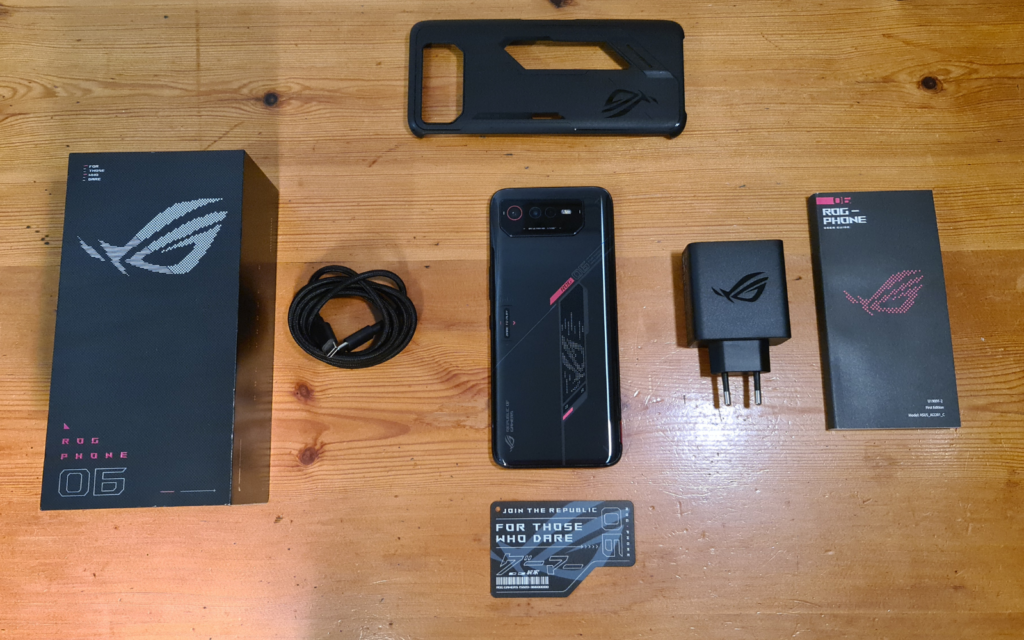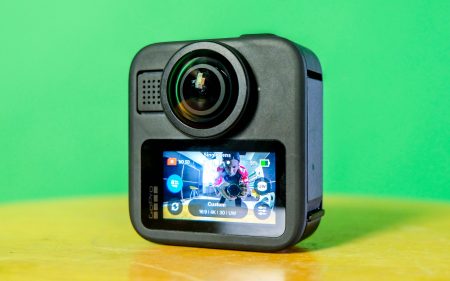Serious South African mobile gamers don't have loads of options at the high end. Thankfully they don't need that many now that Asus has brought the ROG Phone 6 to SA. This is one of the most powerful devices on the market right now. It's only hard to recommend if you don't plan on playing any games with it.
-
Design
-
Performance
-
Battery
-
Camera
-
Price
Simply put, the Asus ROG Phone 6 is the fastest locally available gaming smartphone money can buy. If the only thing you want from your phone is many frames per second – and you can afford the R23,000 price tag – then stop reading and order one. We’ll wait.
For those who also care about other smartphone features like camera performance, battery life, or user experience, you’ll have to keep reading.
A gaming PC in your pocket
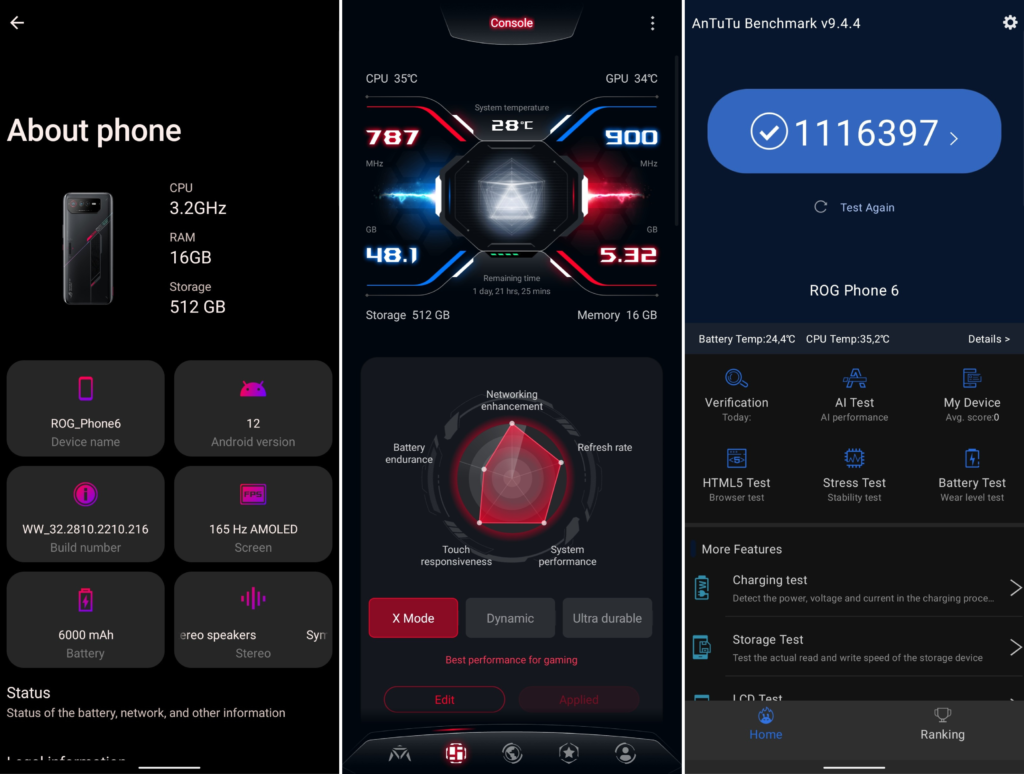
We’re not saying that the ROG Phone 6 is only for gamers. We’re sure hardcore users will appreciate the top-tier specs. Inside, you’ll find a Snapdragon 8+ Gen 1 5G chipset with 16GB of RAM and 512GB of storage.
This chipset isn’t that special. You’ll find one in most new flagships. But Asus has added some special sauce to make it faster and more efficient. It has also optimised internal cooling to improve stability over long gaming sessions.
This translates pretty well in real-world performance. We spent a few hours in Call of Duty, PUBG, Genshin Impact, and Diablo Immortal and experienced decent to good framerates across all titles. Best of all, our fingers only started sizzling after about an hour of Call of Duty on ‘very high’.
If your life isn’t already full of RGB, the design might not be for you. Not only does the Gorilla Glass rear panel feature familiar ROG branding, but there are also two light-up zones – one of which is the ROG logo – that glow when you enable X-mode. More on that later.
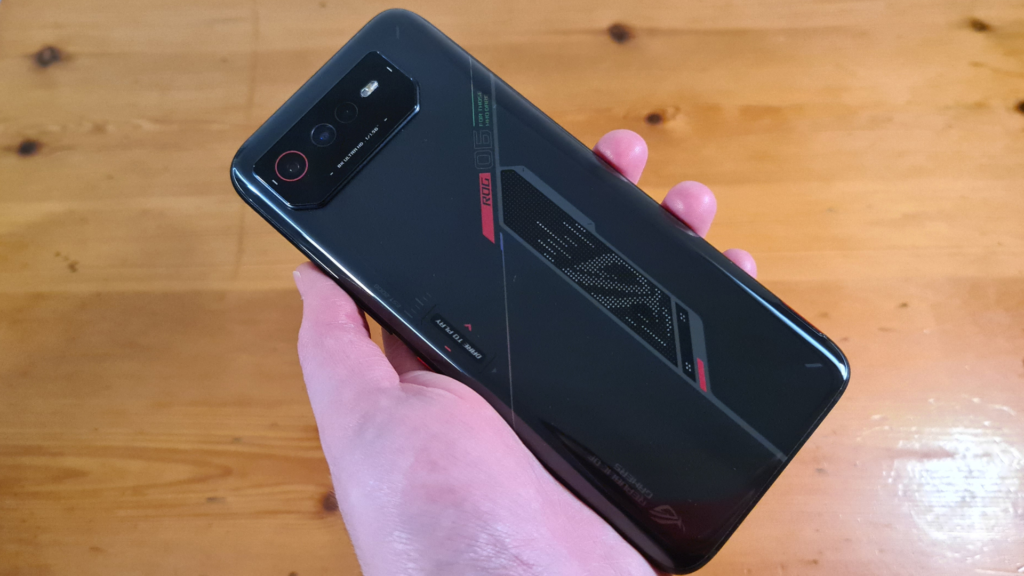 Apart from that, the other major external differences between the ROG Phone 6 and other flagships are the second USB-C port and the inclusion of a headphone jack. A second port is located halfway down the left side of the aluminium frame and is mostly there to connect Asus’ proprietary Aero Active Cooler 6.
Apart from that, the other major external differences between the ROG Phone 6 and other flagships are the second USB-C port and the inclusion of a headphone jack. A second port is located halfway down the left side of the aluminium frame and is mostly there to connect Asus’ proprietary Aero Active Cooler 6.
Sadly, the South African market won’t be getting any of these. At least not officially. But you can still use the side port (or middle port, when holding the phone horizontally, as any self-respecting gamer would) with the bypass charging mode. This will bypass the battery while you’re gaming and only power what’s necessary. We recommend using this wherever possible. It will go a long way in reducing battery wear and improving thermals.
The speed of sound
Gamers that have used wireless earphones will know they can suffer from high latency. That isn’t the case with the ROG Phone 6. The internal DAC (digital to analogue converter) supports up to 32-bit/384kHz audio and with Snapdragon Sound and aptX Adaptive support, wireless latency shouldn’t be a problem. But if you don’t have wireless headphones or would prefer to tether yourself then there’s a dedicated 3.5mm jack just for you.
Unfortunately, its placement isn’t ideal. It shares the bottom of the frame with the slower USB-C port. This means when you’re gaming and you’ve got headphones plugged in and also want to use the two air triggers – two ultrasonic sensors where your fingers would normally find R1 and L1 – your right index finger isn’t going to have a good time unless your headphones have a short 90-degree jack. But simply swapping the two bottom ports around would solve the problem entirely. There’s a free tip, Asus.
Should you forego headphones, you won’t be disappointed by the front-facing stereo speakers. They surprised us with how well-rounded they sounded. We’d even go so far as to say they’re some of the best-sounding smartphone speakers we’ve tested. They’ll also get loud enough for your neighbours to ask if everything is okay on your street’s WhatsApp group. That’s always a plus.
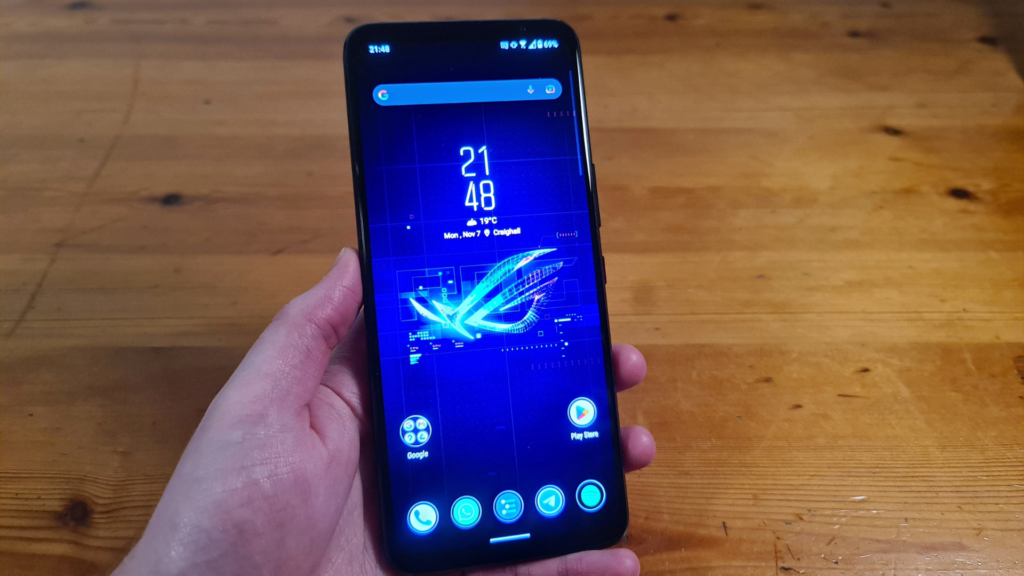 This wouldn’t be much of a gaming phone if it didn’t also have a fantastic screen and we weren’t disappointed here either. This 6.78in AMOLED display has some of the highest specs we’ve seen. The 1,080 x 2,448 resolution is fairly average for a gaming smartphone – turn that up too high and say goodbye to your framerate – but the 165Hz refresh rate and 720Hz touch sampling rate are among the fastest in the industry.
This wouldn’t be much of a gaming phone if it didn’t also have a fantastic screen and we weren’t disappointed here either. This 6.78in AMOLED display has some of the highest specs we’ve seen. The 1,080 x 2,448 resolution is fairly average for a gaming smartphone – turn that up too high and say goodbye to your framerate – but the 165Hz refresh rate and 720Hz touch sampling rate are among the fastest in the industry.
The display’s colour performance was generally good, although we found the default profile to be a little oversaturated with a noticeably cool colour temperature. If you aren’t a fan there are other options to choose from. It also gets sufficiently bright enough when inside or in direct sunlight but you may have to enable auto-brightness on particularly bright days.
Don’t drop it on your foot
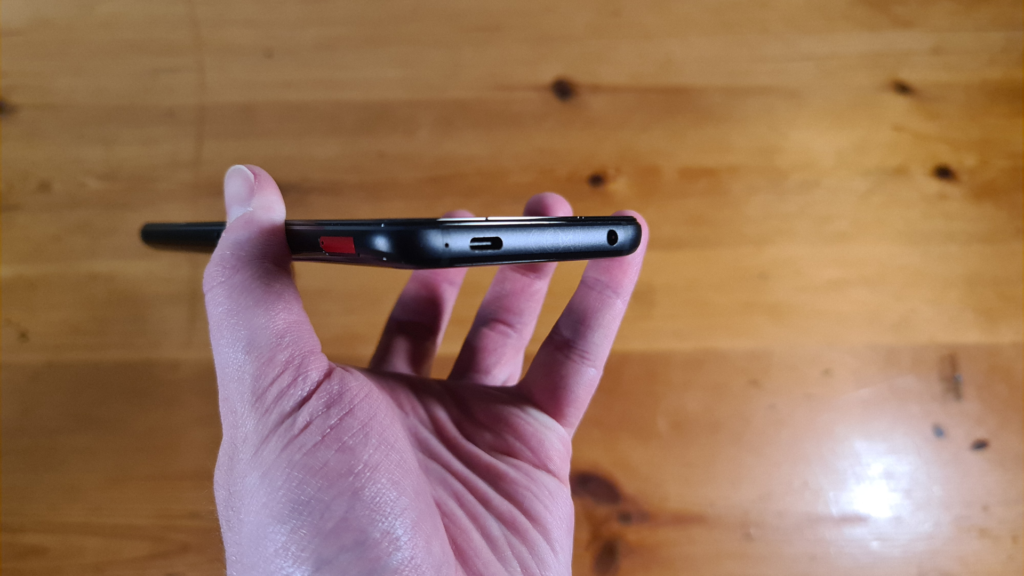 There are two things you’ll notice more or less right away when you pick up the ROG Phone 6. It’s a lot heavier than you’d expect and rather slippery. Its 239g weight probably has something to do with the massive 6,000mAh battery inside.
There are two things you’ll notice more or less right away when you pick up the ROG Phone 6. It’s a lot heavier than you’d expect and rather slippery. Its 239g weight probably has something to do with the massive 6,000mAh battery inside.
The size and weight aren’t exactly dealbreakers but they do make casual one-handed use slightly more difficult. Asus already considered that so it’s built a shortcut for one-handed mode right into the OS. We didn’t end up using it, but someone will, probably.
And what a lovely OS it is. You get Android 12 out of the box with ZenUI on top. Asus is fairly conservative in the changes it makes to Android so it’s pretty close to a stock Android experience – we’re big fans.
We’re also big fans of not having to uninstall a myriad of pre-installed apps. That isn’t to say the ROG Phone 6 doesn’t have any. The difference here is the apps that do come pre-installed you’ll want to keep. Namely, Armory Crate and Game Genie.
Armory Crate acts like a hub of sorts. You’ll find your installed games here and controls for all the Asus accessories you don’t have. This is also what drives the in-game overlay. You use this to tweak settings, performance profiles, or keep an eye on temperatures.
Game Genie is the real star here. We were surprised with just how much functionality it provides. You can create game-specific profiles with custom button mappings and set up macros and crosshair overlays if you weren’t shown enough love as a child need some extra help.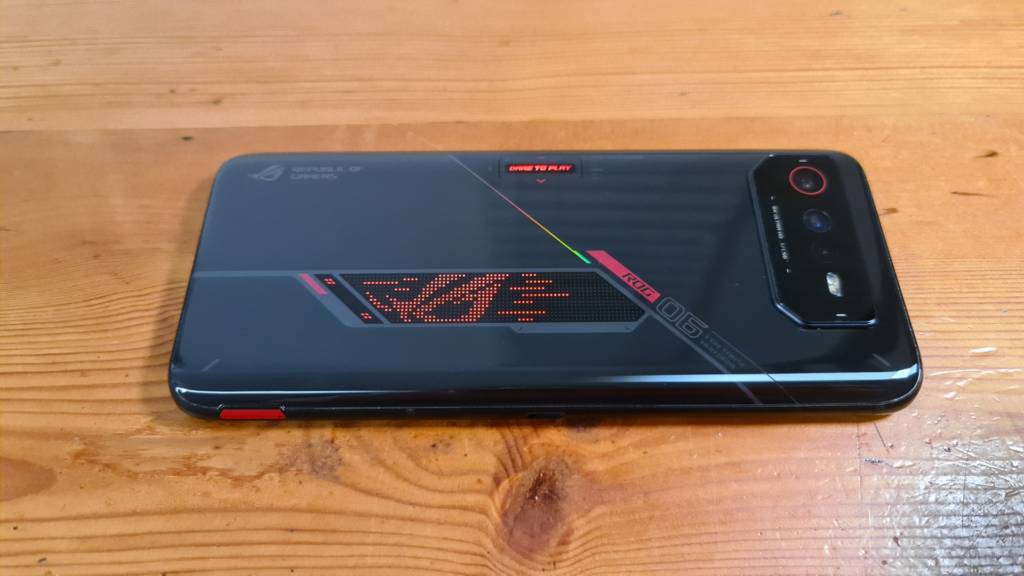
A couple of themes come pre-installed, one with a heavy gamer aesthetic and another slightly calmer theme. The default gamer-focused theme even features an adaptive wallpaper when you squeeze the side triggers to activate X-mode.
When this happens you can almost feel the device change in your hand, like switching to Sport mode in a sports car. Thematic accents change to red, the back zones light up, and everything goes quiet as the phone emits an audio cue signifying that X-mode is engaged.
Give a couple of these to Eskom
Crack the ROG Phone 6 open (we didn’t) and you’ll find two 3,000mAh cells, for a total of 6,000mAh. That’s already more than most flagships. This monster battery is paired with a 65W charging brick which you get for free.
Battery life was superb, as expected from one this size. Even with the dials cranked up and X-mode enabled. The only caveat to this is the lack of wireless charging. The feature is usually a staple in flagship phones but its inclusion would probably be problematic.
If you’re not trying to squeeze every drop of performance out of it, the battery will last close to two full days. But even when it runs low, the 65W charger can get it back up to full in around 40 to 50 minutes. Asus has even included some good battery health settings, like limiting maximum battery capacity or slowing the charging speed down during prolonged charging – when plugged in overnight, for example – to improve battery longevity.
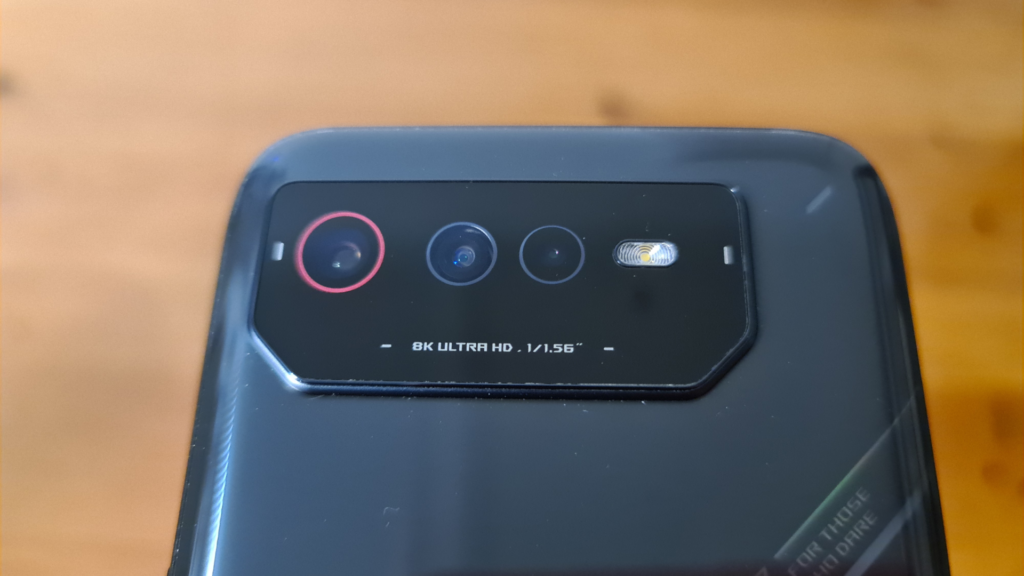 Then there’s the camera array. The ROG Phone 6 is equipped with a 50MP main sensor, 13MP ultrawide, and a 5MP macro camera. If you were hoping for a whopping big change over the ROG Phone 5 then we bring disappointing news.
Then there’s the camera array. The ROG Phone 6 is equipped with a 50MP main sensor, 13MP ultrawide, and a 5MP macro camera. If you were hoping for a whopping big change over the ROG Phone 5 then we bring disappointing news.
The main sensor manages to get the job done. The other two, not so much. The 50MP affair (Sony’s IMX 766) will take decent snaps in good light with sufficient colour accuracy and depth for the ‘Gram. But the lack of optical image stabilisation on any of the sensors kinda sucks, unless you’re a surgeon. It’s also the only one of the three with auto-focus.
For shooting video, your options are 8K at 24fps, 4K at up to 60fps, FHD at up to 240fps, or 720p at 480fps in slo-mo mode. There is also a 12MP selfie cam up front, embedded in the top bezel. This will produce passable shots if you don’t go pixel-peeping.
Mediocre camera performance is expected on gaming-focused smartphones. The cameras are here because it would be weird not to have them when you’re paying over R20k. This is a gaming phone first, all other concerns take a back seat.
Asus ROG Phone 6 verdict
South African mobile gamers that want the best performance should definitely consider the ROG Phone 6. It is by no means a perfect device. Its shortcomings could be hard to overlook for some. But it smashes what it sets out to do. There are better options if you need to get the most bang for your buck. But those options will cut corners in other areas so it’ll be up to you to decide what matters more. While you decide, we’ll be playing CoD.

